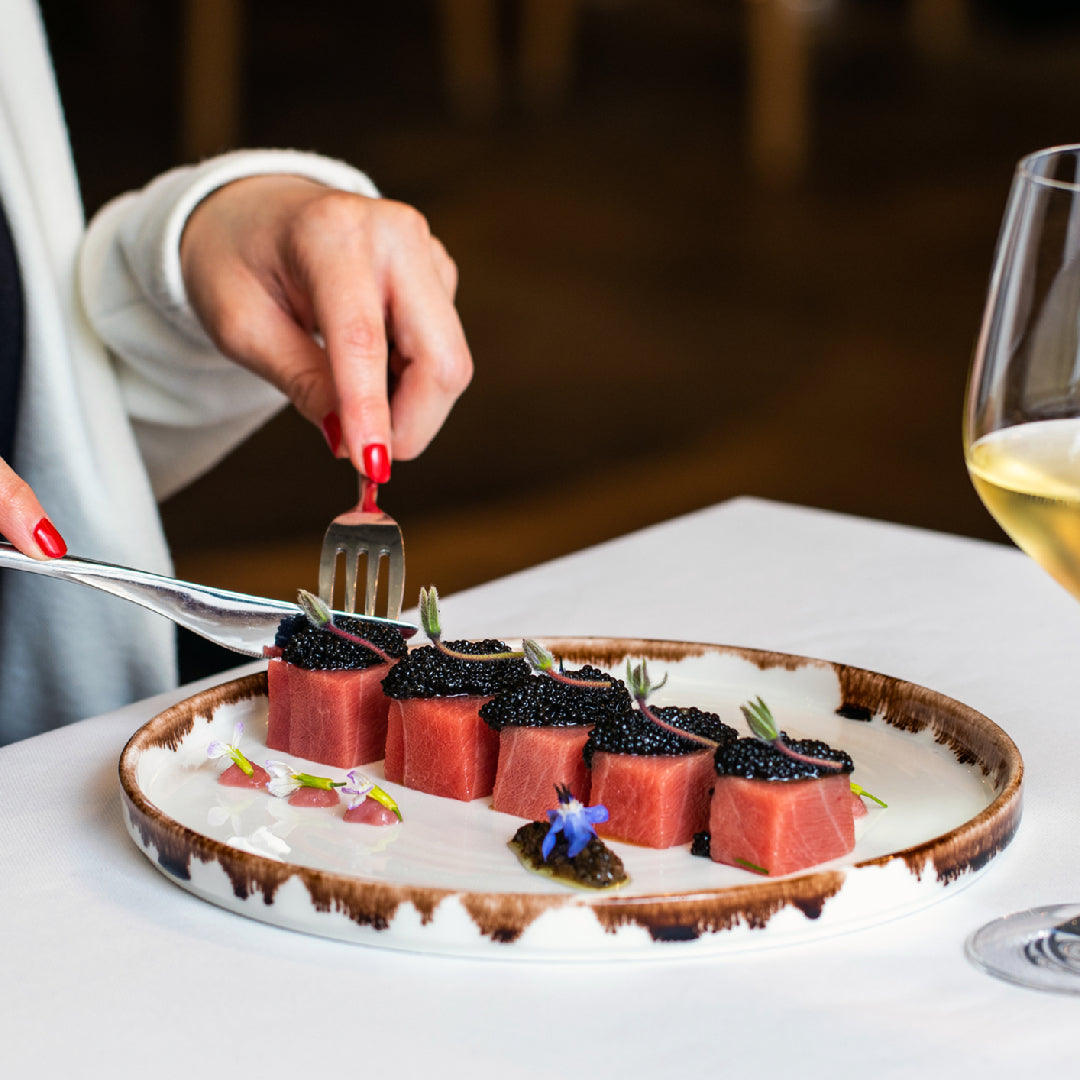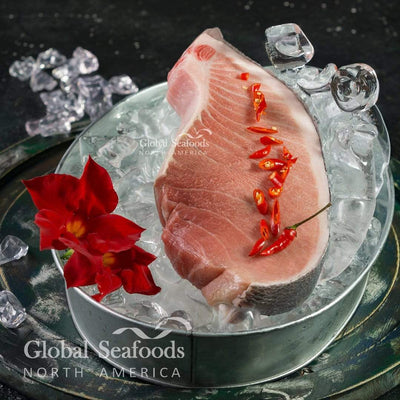The Ultimate Bluefin Tuna Fishing Gear Guide - Everything You Need to Know

Bluefin tuna fishing gear guide
Bluefin tuna are among the most sought-after fish in the world due to their size, power, and culinary value. However, catching these powerful ocean predators requires specialized fishing gear and a deep understanding of techniques and sustainability practices. From rod-and-reel setups to advanced longlining gear, each method has its unique benefits, challenges, and environmental impact. This guide explores the essential Bluefin tuna fishing gear, fishing techniques, and sustainable practices to help ensure that the Bluefin populations remain healthy for future generations.
For expert videos on Bluefin tuna and sustainable seafood, explore the Global Seafoods YouTube Channel.
Why Specialized Fishing Gear Matters for Bluefin Tuna
Catching Bluefin tuna is no easy feat. These fish can reach speeds of up to 40 miles per hour and weigh up to 1,500 pounds, making them a formidable challenge for even the most experienced anglers. The strength, size, and endurance of Bluefin tuna demand specialized gear to handle the fight and ensure a successful catch. Additionally, sustainable fishing practices are essential in choosing the right equipment to reduce bycatch and minimize harm to marine ecosystems.
“Using appropriate fishing gear for Bluefin tuna is essential not only for a successful catch but also to protect marine ecosystems,” states the World Wildlife Fund (WWF).
Essential Bluefin Tuna Fishing Gear: Rod-and-Reel Setups
Rod-and-reel setups are popular among sport fishers and recreational anglers targeting Bluefin tuna. This setup allows for a controlled, one-on-one battle with the fish and minimizes the chances of catching non-target species, making it a sustainable choice.
Rod and Reel Components for Bluefin Tuna
- Heavy-Duty Rods: Rods must be strong and flexible to withstand the power of Bluefin. Most anglers prefer rods rated between 50 to 130 pounds, with a length of around 6 to 8 feet.
- High-Quality Reels: Lever drag reels are ideal for Bluefin tuna fishing, providing smooth drag control to tire out the fish gradually.
- Braided Line: Braided fishing lines offer high strength with minimal stretch, crucial for handling the force of large Bluefin.
Pros of Rod-and-Reel Fishing
- Low Environmental Impact: Allows anglers to catch one fish at a time, reducing bycatch and environmental impact.
- Selective Fishing: Anglers can target specific fish, contributing to sustainable fishing practices.
- Sporting Challenge: Many sport fishers prefer rod-and-reel setups for the challenge and excitement it provides.
Cons of Rod-and-Reel Fishing
- Lower Efficiency: Compared to commercial methods, rod-and-reel fishing yields fewer catches, limiting its commercial scalability.
- Physical Demands: Fighting a Bluefin tuna on a rod-and-reel setup requires physical endurance, making it challenging for some anglers.
For premium Bluefin tuna for your next meal, explore Bluefin Tuna Products.
Longline Fishing Gear: High Volume with Higher Risks
Longlining involves using a long, main line with hundreds or thousands of baited hooks attached at intervals. This method is used in commercial Bluefin tuna fishing to cover large areas and increase the likelihood of a catch.
Essential Longline Gear
- Mainline: Typically, a longline mainline is made of heavy-duty nylon or polypropylene, allowing it to extend miles.
- Branch Lines and Hooks: Branch lines connect to the mainline with baited hooks to catch tuna.
- Buoys and Floats: These keep the line suspended at the appropriate depth for Bluefin tuna, typically deeper in the water column.
Pros of Longline Fishing
- High Efficiency: Longlines cover vast areas, increasing the catch rate and maximizing commercial efficiency.
- Effective for Targeting Large Fish: Longlines can be adjusted to specific depths, allowing them to target larger Bluefin tuna.
Cons of Longline Fishing
- High Bycatch Risk: Longlines often capture non-target species, including sharks, dolphins, and sea turtles, contributing to ecological harm.
- Environmental Impact: Lost longlines and hooks can become "ghost gear," polluting the ocean and harming marine life.
“Longline fishing can be effective but comes with significant environmental costs, including high rates of bycatch,” according to Oceana, a leading ocean conservation organization.
If you’re looking for an alternative to Bluefin, try Ahi Tuna Steaks, a sustainable choice that’s rich in flavor.
Purse Seining Gear: Netting Large Quantities of Tuna
Purse seining is a commercial fishing method where a large net encircles a school of fish. Once the fish are surrounded, the bottom of the net is pulled closed, capturing everything inside. This technique is efficient but comes with environmental challenges.
Essential Gear for Purse Seining
- Purse Seine Nets: Large, circular nets that can be hundreds of meters long, designed to capture entire schools of Bluefin tuna.
- Buoys and Floats: These help keep the net open and stable, ensuring effective capture.
- Purse Line: The purse line at the bottom of the net is drawn tight to close off the bottom, preventing fish from escaping.
Pros of Purse Seining
- High Yield: Capable of capturing large numbers of Bluefin tuna in a single deployment.
- Cost-Effective: Requires less fuel and labor compared to other large-scale fishing methods, making it economical.
Cons of Purse Seining
- Bycatch and Overfishing Risks: Non-target species can be trapped, and the method can deplete local tuna populations if not properly managed.
- Habitat Disruption: Purse seines used near sensitive marine areas may harm coral reefs or other habitats.
To enjoy a responsibly sourced tuna option, check out Sushi-Grade Tuna Saku Blocks.
Handline and Pole-and-Line Fishing Gear: Traditional and Sustainable
Handline and pole-and-line methods are highly selective and sustainable, making them ideal for small-scale Bluefin tuna fishing. In these methods, fishers use baited lines to catch one fish at a time.
Essential Gear for Handline and Pole-and-Line Fishing
- Baited Line and Hook: A single line with a baited hook, allowing the fisher to control each catch.
- Manual or Electric Reels: For deeper waters or larger fish, electric reels help lift the fish with minimal effort.
- Poles for Pole-and-Line Fishing: Poles are used to cast and control the line, making the process efficient and sustainable.
Pros of Handline and Pole-and-Line Fishing
- Minimal Bycatch: The high selectivity of these methods reduces bycatch, preserving marine ecosystems.
- Sustainable: These methods have a low environmental impact, making them ideal for eco-friendly fishing practices.
- Quality of Catch: Fish are typically in better condition and command a higher price on the market.
Cons of Handline and Pole-and-Line Fishing
- Labor Intensive: These techniques are time-consuming and require significant labor, limiting catch quantities.
- Limited to Smaller Operations: These methods are less suitable for large-scale commercial fishing due to the lower yield.
“Handline and pole-and-line fishing are among the most sustainable methods, allowing fishers to target specific tuna with minimal environmental impact,” notes the Marine Stewardship Council (MSC).
For a fresh and sustainable choice, try Albacore Tuna Fresh Whole.
Choosing the Right Gear for Sustainable Bluefin Tuna Fishing
With increased awareness of overfishing and marine conservation, choosing sustainable Bluefin tuna fishing gear is more important than ever. Whether you’re a commercial fisher or recreational angler, selecting the appropriate gear can help reduce the impact on ocean ecosystems and preserve Bluefin tuna populations.
Key Considerations for Sustainable Bluefin Tuna Fishing
- Select Gear with Low Bycatch: Techniques like handline and pole-and-line fishing are ideal for minimizing bycatch and reducing environmental damage.
- Avoid Gear That Damages Habitats: Choose fishing methods that do not disrupt marine habitats, such as coral reefs or seagrass beds.
- Use Recyclable or Biodegradable Gear: Opt for environmentally friendly materials that minimize pollution if lost or discarded.
Consumer Tip: When purchasing tuna products, look for sustainably sourced options to support responsible fishing practices. Visit Global Seafoods for a selection of high-quality, sustainably sourced tuna.
Frequently Asked Questions on Bluefin Tuna Fishing Gear
Q1: What is the best gear for sustainable Bluefin tuna fishing?
Handline and pole-and-line gear are the most sustainable options, allowing fishers to target individual fish with minimal bycatch.
Q2: Why is longline fishing controversial?
Longline fishing often results in high bycatch rates, including sharks and other marine species, which negatively impact ecosystems.
Q3: How does purse seining affect marine habitats?
Purse seining can disrupt sensitive marine habitats, such as coral reefs, especially when nets are used in close proximity to these areas.
Q4: Can I support sustainable fishing through my seafood choices?
Yes, choosing products labeled as sustainably sourced, like those from Global Seafoods, promotes responsible fishing practices.
Q5: What makes rod-and-reel fishing a sustainable choice?
Rod-and-reel fishing targets one fish at a time, reducing bycatch and allowing anglers to practice selective fishing.
Q6: Where can I find sustainably sourced tuna for my meals?
Visit Global Seafoods to purchase high-quality, sustainably sourced tuna products.
Also in News

How to Make Sea Bream Sushi With Dry-Aged Tuna & Crab Roll — Step-by-Step With Chef Joshua
A complete guide to making Sea Bream sushi at home, including filleting, curing, slicing, and building a Dry-Aged Tuna & Crab sushi roll. Chef Joshua shares professional tips for restaurant-quality results.

Boiled Crab for Game Night: Everything You Need for a Perfect Seafood Party
Take your game night to the next level with a Boiled crab party. Learn the best recipes, cooking tips, and hosting hacks for a memorable seafood feast.

Boiled Crab for Date Night: A Romantic Guide to the Perfect Seafood Feast
Make your next date night unforgettable with a romantic Boiled crab experience. This guide covers everything you need to know, from ambiance to the best crab varieties.

